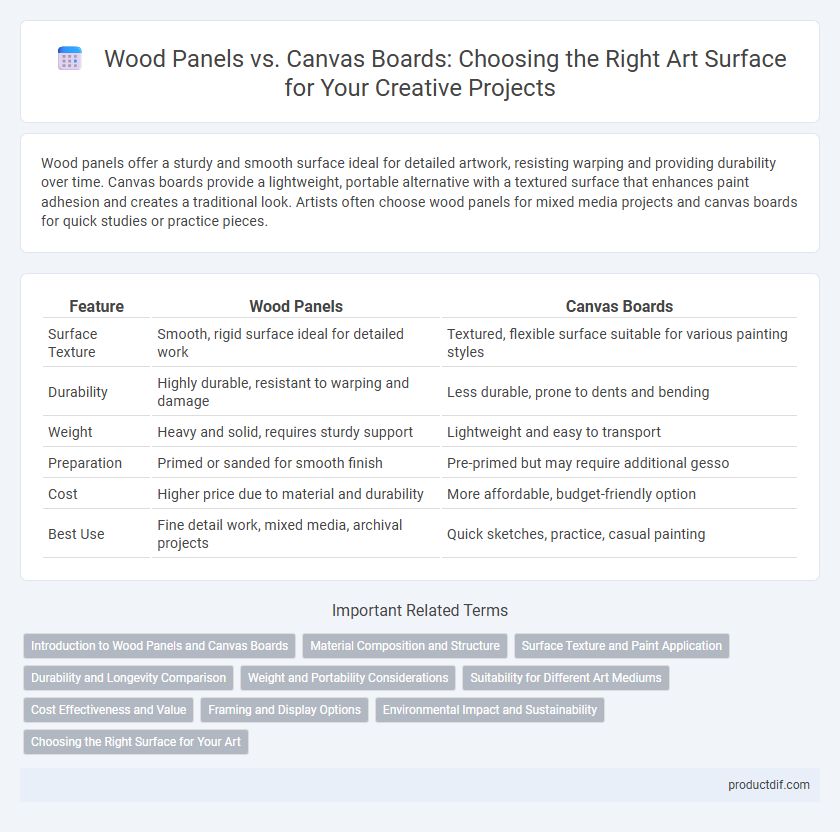Wood panels offer a sturdy and smooth surface ideal for detailed artwork, resisting warping and providing durability over time. Canvas boards provide a lightweight, portable alternative with a textured surface that enhances paint adhesion and creates a traditional look. Artists often choose wood panels for mixed media projects and canvas boards for quick studies or practice pieces.
Table of Comparison
| Feature | Wood Panels | Canvas Boards |
|---|---|---|
| Surface Texture | Smooth, rigid surface ideal for detailed work | Textured, flexible surface suitable for various painting styles |
| Durability | Highly durable, resistant to warping and damage | Less durable, prone to dents and bending |
| Weight | Heavy and solid, requires sturdy support | Lightweight and easy to transport |
| Preparation | Primed or sanded for smooth finish | Pre-primed but may require additional gesso |
| Cost | Higher price due to material and durability | More affordable, budget-friendly option |
| Best Use | Fine detail work, mixed media, archival projects | Quick sketches, practice, casual painting |
Introduction to Wood Panels and Canvas Boards
Wood panels offer a rigid surface made from tightly bonded wood fibers, preferred for their durability and smooth texture in detailed painting techniques. Canvas boards consist of canvas fabric mounted on a stiff backing, providing a lightweight and portable option suitable for acrylic and oil paints. Both support various mediums, with wood panels excelling in longevity and canvas boards favored for affordability and ease of use.
Material Composition and Structure
Wood panels feature a solid, rigid core made from plywood or MDF, providing a durable and stable surface that resists warping and ensures longevity in artwork. Canvas boards consist of a canvas fabric stretched and glued over a rigid backing, typically cardboard or fiberboard, offering a lightweight and portable option but with less structural support than wood panels. Both materials influence paint absorption and texture, with wood panels offering a smoother surface ideal for fine detail, while canvas boards present a textured surface suited for expressive brushwork.
Surface Texture and Paint Application
Wood panels offer a smooth, rigid surface ideal for detailed brushwork and mixed media applications, providing less texture variation compared to canvas boards. Canvas boards feature a textured fabric surface that enhances paint adhesion and creates natural variations in brush strokes, benefiting acrylic and oil painters seeking expressive effects. Both surfaces influence paint drying time and absorption, with wood panels generally requiring less priming and allowing for finer detail retention.
Durability and Longevity Comparison
Wood panels offer superior durability and longevity compared to canvas boards due to their rigid, non-flexible surface which resists warping and tearing over time. Canvas boards, made from canvas adhered to a cardboard backing, are more prone to damage from moisture and general wear, leading to a shorter lifespan. Artists seeking long-lasting, stable painting surfaces often prefer wood panels for their resilience and archival quality.
Weight and Portability Considerations
Wood panels offer a heavier and more rigid surface compared to canvas boards, making them less ideal for frequent transport but providing excellent stability for detailed work. Canvas boards are lightweight and highly portable, favored by artists who need a durable yet easy-to-carry option for outdoor painting or studio mobility. Choosing between wood panels and canvas boards depends on balancing the need for weight stability against the convenience of portability in various painting environments.
Suitability for Different Art Mediums
Wood panels offer a sturdy and smooth surface ideal for oil paints, acrylics, and mixed media due to their durability and resistance to warping. Canvas boards are lightweight and portable, making them suitable for acrylics and watercolors but less effective for heavy oil paints that may cause cracking. Artists select wood panels for detailed work and longevity, while canvas boards favor quick sketches and practice pieces.
Cost Effectiveness and Value
Wood panels offer greater durability and a smooth surface, making them a cost-effective option for artists seeking long-lasting support for acrylic and oil paintings. Canvas boards provide an affordable alternative with lightweight and portable benefits, ideal for students and hobbyists on a budget. Both choices deliver good value depending on the artist's priorities for texture, longevity, and price.
Framing and Display Options
Wood panels offer superior rigidity and durability, making them ideal for framing under glass or mounting without warping over time, while canvas boards provide a lightweight, cost-effective alternative suitable for framing with standard matting and glazing options. The solid structure of wood panels supports a variety of display methods including floating frames or direct wall mounting, enhancing the artwork's modern aesthetic. Canvas boards, being thinner and more flexible, are often displayed in traditional frames or gallery wraps, offering versatility for casual and professional presentation.
Environmental Impact and Sustainability
Wood panels often have a higher environmental impact due to deforestation and the use of non-renewable resins or adhesives, whereas canvas boards typically use cotton or linen fibers that can be sourced sustainably with organic farming practices. Canvas boards are generally more eco-friendly when produced with water-based, non-toxic primers and recycled materials, reducing landfill waste and pollution. Choosing sustainably harvested wood panels certified by FSC or opting for canvases with biodegradable backing enhances the overall sustainability of art supplies.
Choosing the Right Surface for Your Art
Wood panels provide a sturdy, durable surface ideal for detailed painting techniques and mixed media applications, resisting warping and lasting for decades. Canvas boards offer a lightweight, budget-friendly option with a textured surface that mimics stretched canvas, suitable for practice, studies, and short-term projects. Selecting between wood panels and canvas boards depends on your artistic style, desired longevity, and the type of paint used, with acrylics and oils performing well on both but requiring proper priming.
Wood Panels vs Canvas Boards Infographic

 productdif.com
productdif.com